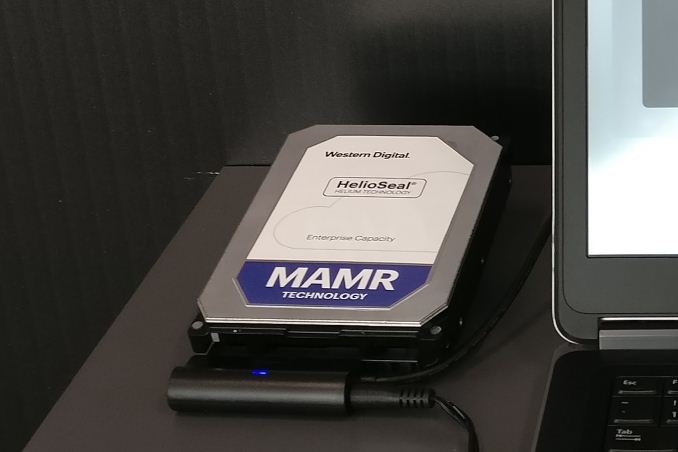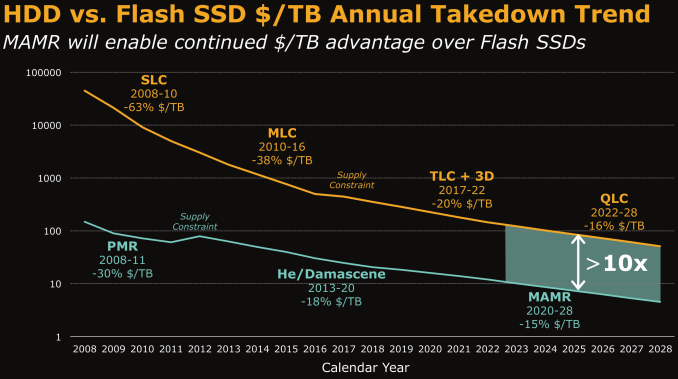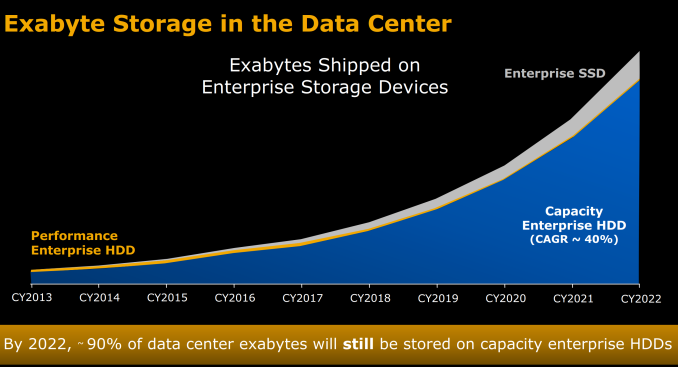Western Digital Stuns Storage Industry with MAMR Breakthrough for Next-Gen HDDs
by Ganesh T S on October 12, 2017 8:00 AM EST
Yesterday, Western Digital announced a breakthrough in microwave-assisted magnetic recording (MAMR) that completely took the storage industry by surprise. The takeaway was that Western Digital would be using MAMR instead of HAMR for driving up hard drive capacities over the next decade. Before going into the specifics, it is beneficial to have some background on the motivation behind MAMR.
Hard drives may be on the way out for client computing systems, but, they will continue to be the storage media of choice for datacenters. The Storage Networking Industry Association has the best resources for identifying trends in the hard drive industry. As recently as last year, heat-assisted magnetic recording (HAMR) was expected to be the technology update responsible for increasing hard drive capacities.

Slide Courtesy: Dr.Ed Grochowski's SNIA 2016 Storage Developer Conference Presentation
'The Magnetic Hard Disk Drive: Today’s Technical Status and Its Future' (Video, PDF)
Mechanical Hard Drives are Here to Stay
One of the common misconceptions amongst readers focused on consumer technology relates to flash / SSDs rendering HDDs obsolete. While using SSDs over HDDs is definitely true in the client computing ecosystem, it is different for bulk storage. Bulk storage in the data center, as well as the consumer market, will continue to rely on mechanical hard drives for the foreseeable future.
The main reason lies in the 'Cost per GB' metric.
Home consumers are currently looking at drives to hold 10 TB+ of data, while datacenters are looking to optimize their 'Total Cost of Ownership' (TCO) by cramming as many petabytes as possible in a single rack. This is particularly prevalant for cold storage and archival purposes, but can also expand to content delivery networks. Western Digital had a couple of slides in their launch presentation yesterday that point towards hard drives continuing to enjoy this advantage, thanks to MAMR being cost-effective.
Despite new HDD technology, advancements in solid state memory technology are running at a faster pace. As a result SSD technology and NAND Flash have ensured that performance enterprise HDDs will make up only a very minor part of the total storage capacity each year in the enterprise segment.
The projections presented by any vendor's internal research team always need to be taken with a grain of salt, but given that SanDisk is now a part of Western Digital the above market share numbers for different storage types seem entirely plausible.
In the next section, we take a look at advancements in hard drive technology over the last couple of decades. This will provide further technical context to the MAMR announcement from Western Digital.












127 Comments
View All Comments
DanNeely - Thursday, October 12, 2017 - link
The sentences are talking about 10/15k RPM SAS drives, the graph is 5.4/7.2k bulk storage drives. The former are almost as expensive as SSDs but still have all the big HDD limitations.Dug - Thursday, October 12, 2017 - link
Nice article. This is the type of writing I miss in the old Anandtech.Krysto - Thursday, October 12, 2017 - link
The NSA will love this.melgross - Thursday, October 12, 2017 - link
I'm not worried about the NSA. Anything they want, they can get from Google.iwod - Thursday, October 12, 2017 - link
I have always wondered how the Heck would HAMR work in such environment, heat takes time, and spinning disk is fast. But then I am no expert, so I could only wait. Turns out HAMR really dont work. And would HAMR work within Helium?Now MAMR suddenly comes out of no where. And I assume it would work with Helium too!
My problem is 40TB HDD in 2025 is still too slow. WD could have produced this now at 1.2x cost of $/GB of current HDD and cloud vendor would still slap them up like crazy.
melgross - Thursday, October 12, 2017 - link
The greater the information density, the faster it works, particularly for sequential reads/writes.The largest/fastest HDDs now do over 265MB/sec. I would imagine that with 4 times the density, these speeds would increase several times.
Lolimaster - Thursday, October 12, 2017 - link
With more self learning microchips/code, I think HDD's should include some kind of NVRAM as buffer/cache for 4k content specially the ones detected as part of OS/programs.Most of the OS/programs should fit on 16-32GB NVRAM cache. Even with "novelty" prices, intel's optane are around $45-80 at final consumer prices.
Or just a quality 128GB MLC SSD that could be used a big partition with the HDD part or as a SSD only leaving the HDD part for data. Would barely increase the prices of a 4-10TB by $50-60
Lolimaster - Thursday, October 12, 2017 - link
Even with a low capacity NVRAM/SSD cache windows should use this space for image thumbnails for example and frequent apps (or let you pick what you want to be written to the buffer).Magichands8 - Thursday, October 12, 2017 - link
I still think HDDs are dead. I mean this is fascinating technology but how does it allow HDDs to really compete with SSDs? They say by 2025 we'll have 40TB MAMRs. ~40TB SSDs are already available today. SSDs don't suffer from any of the mechanical issues of HDDs, don't necessarily produce as much heat and have performance characteristics which are an order of magnitude above and beyond what HDDs are capable, or even going to be capable of. If performance didn't matter and price per TB was the only thing that did then tape storage would seem to be the better option at those capacities. As far as I know, tape storage is simpler, way cheaper and comes with many side benefits. Obviously HDDs are cheaper than SSDs are today but how expensive will SSDs be in 2025? And the only thing SSD manufacturers would have to do to catch up is build up production capacity for what is already a known quantity and proven technology.pavag - Thursday, October 12, 2017 - link
Well, HAMR was too little, too late, to compete with SSD.The calculation of price per GB didn't accounted that price/GB depends on how many units are sold. As SSD eat more and more market from HD, price/GB falls for SSD, and increases for HD.
At the time HAMR was expected to enter the market, the marketshare for HD would be a niche too small to support the expected low price per GB.
MAMR will save the price advantage for HD, for a while, but it may be the last generation of HD.